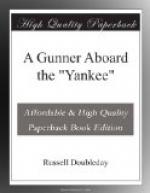The following days until the eighth of May were days of manual labor, which hardened our muscles and placed a fine edge on our appetites. To see the men who had been accustomed to a life of luxury toiling away with rope and scrubbing brush and paint pot, working like day laborers, and happy at that, was really a remarkable spectacle. For my part, I noticed with surprise that scratched and bruised hands—scratched so that the salt water caused positive pain—did not appeal to me. I tore off a corner of my right thumb trying to squeeze a large box through the forward hatch, and the only treatment I gave it was a fragment of rather soiled rag and a little vaseline borrowed from a mate. To quit work and apply for the first aid to injured never struck me. Ashore I would probably have called a doctor.
The day before we left the yard one of my mates sprained his back lifting a box of canned meat. In civil life he had been a lawyer with a promising practice, his office being with one of the best known men of the bar. He gave it up and joined the Naval Reserves because, as he expressed it, “To fight for one’s country is a patriot’s first duty.” When the accident happened, he refused to go below to the sick bay until the doctor stated that rest for a few days at least was absolutely necessary.
“It isn’t that I mind the hurt, boys,” he said, with a smile, as he was assisted to the hatch, “but I hate to be knocked out in my first engagement, and that with a box of canned corned beef.”
The monotony of work was broken on the ninth of May, when preparations were made to leave the yard. The destination was only Tompkinsville, but there was not a man on board but felt that, as the last hawser was cast off, we were fairly started on our cruise in search of action. As the “Yankee” was assisted away from the wharf by a Government tug, a number of friends gathered ashore cheered lustily and waved their hats and handkerchiefs. The scene had been repeated time without end, no doubt, but it went to our hearts all the same, and there was many a husky note in the cheers we gave in return.
There was also encouragement in the whistles we received as we dropped down the East River, and we felt as if our small share in the war would be appreciated by those compelled to stay at home. We steamed directly to the vicinity of Fort Wadsworth, Staten Island, anchored off Tompkinsville, and then picked up a berth there for the night. Half way down the bay we met a tug carrying a committee from the “Sons of the Revolution” of New York State. The committee had been selected by the society to present us with a set of colors. The tug accompanied us to our anchorage, then the committee came on board. The ceremony of presentation was rather picturesque.




